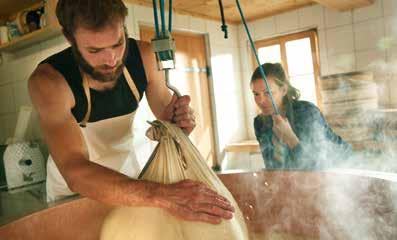
4 minute read
Käsestrasse & Bregenzerwald Culinary Delights Region
Falzalpen cheese cellar in Egg-Schetteregg
How come a valley community in which, a century ago, Sunday dinner comprised a sort of wheat flour mash (with maize grits the rest of the week) is now a gourmet region with specialities whose origins are protected and where refined gastronomy is at home in many restaurants?
The Bregenzerwald is an Austrian gourmet region. These days, the word “gourmet” is used all too frequently in advertising: however, the expression “gourmet region” has a specific meaning: it is a registered brand by the Austrian Ministry for Food and the AMA (Agrarmarkt Austria), wishing to remind consumers of regional specialities. The basic prerequisites are that the ingredients come from the region, that production is regional, and that the products are firmly rooted in regional gastronomy. In the Bregenzerwald, this means alpine cheese. Every year, approximately 3,000 tons of alpine cheese are produced in the valley’s 17 dairies. Every year, 200 tons of alpine cheese are handmade by the 70 or more dairy alps every summer. The special thing about this cheese is the silo-free milk it is produced from, since only 3% of EU dairy farmers produce in this way, i.e. their cows never eat silo fodder – instead, between May and October, they only eat grass and herbs. During the winter, they only eat the air-dried hay from valley meadows. In the so-called three-stage farming method, following their winter in the barn, the animals graze on the mountain pastures located at medium height (around 900 m) during the spring and the autumn, and on the high mountain pasture during the summer. The mountain pastures are run as a collective, since the farmers only have an average of 12 cows in the barn. The three-stage farming method (which was included in the national UNESCO list of immaterial cultural assets in spring 2011) in particular gives the alpine cheese the special flavour which means it can easily contend with the well-known European full-fat cheeses. It has been like this for a long time: back at the start of the 19th century, the inhabitants of the Bregenzerwald sold over 30.000 kg of cheese to the monarchy and abroad. In 1877, Karl von
Seyffertitz wrote: “Everywhere – including in the cheerful Vorderwald, in Hittisau and Lingenau, you will meet a unique people in strange national dress in wood-panelled parlours with floors scrubbed white, with shiny door handles – the men busy looking after a dairy breed of cow and overseeing the production of a popular, world-famous fine cheese, the women busy with elaborate whitework embroidery.” However, it wasn’t the producers back then who made all the money – it was the sellers. The Schnepfau local Josef Ambros Moosbrugger, for example, made so much profit from selling cheese that he could afford a city palace in Milan. No doubt he dined differently to the people back home, where cooking over an open fire resulted above all in simple pan-fried dishes such as the “Riebel” and the “Schwozermuas”. Up on the alp, flour, salt, butter, quark and cheese were the main ingredients. The recipe for “Schwozermus” – named for the woodcutters from Schwaz – was: “Water, flour, salt, dripping – and that’s it!” The lack of bread on the alp gave rise to the “Käsknöpfle”, to “Sig”, known only in the Bregenzerwald and which is caramelised lactose, since they wanted to make a further product from the whey. The passage of this modest alp fare to the current first-class restaurants in the Bregenzerwald – which now use over 60 regional types of cheese – went through a series of changes which demanded quality rather than quantity. These include the 1997 EU Protection of Origin of alpine and mountain cheeses, the establishment of the “KäseStrasse Bregenzerwald” in 1998 as a network of farmers, alpine dairies, craftsmen, publicans and businesses, the “Gourmet region of the Bregenzerwald” in 2005, the Vorarlberg quality marketing “luag druf” in 2005, the inclusion of Bregenzerwald mountain cheese into the “Ark of taste” by Slow Food 2008, and the “Bregenzerwald Gourmet Days” by the KäseStrasse in July 2009. The toughest taste test is still the most regional however: every year, alpine and mountain cheese is judged in Schwarzenberg. The winner at this event is enough to satisfy any gourmet’s taste buds.
The KäseStrasse Bregenzerwald is an association of farmers and alps, alpine dairy farmers and cheesemakers, cheesemongers and restaurants, museums and cable car operators, members of the tourism industry and partners from the worlds of trade and commerce. The over 170 partners which make up the KäseStrasse network are joined together in the objective of maintaining and preserving taste and regional culture.
tip: käsestrasse & tasting
Programme: „World of enjoyment in the Bregenzerwald Cheese Cellar in Lingenau “ View through the glass wall into the cheese cellar where around 32,500 wheels of alpine and mountain cheese are maturing, information pertaining to cheese culture in the Bregenzerwald, the maturing and storage of alpine cheese, showing of the KäseStrasse film, tasting of the diverse types of cheese and other specialities Information & registration KäseStrasse Bregenzerwald T +43 (0)5513 42870-41 www.kaesestrasse.at









